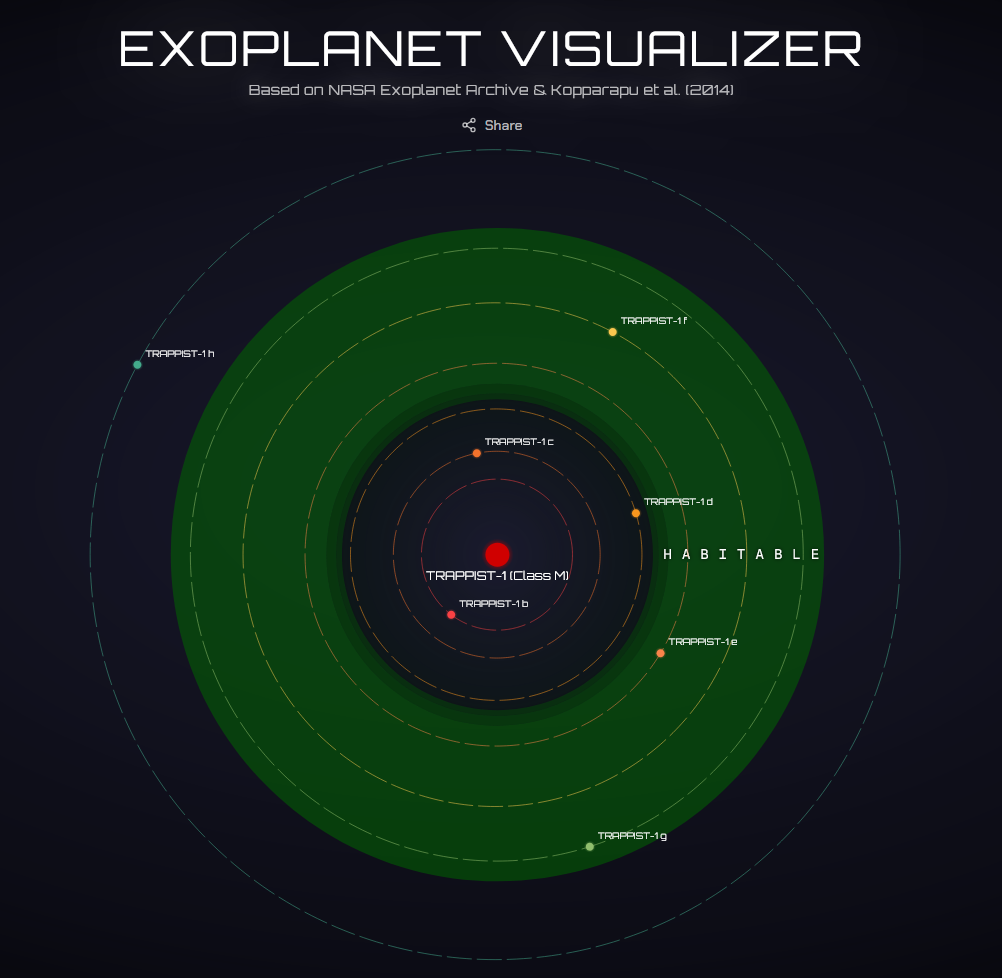Exoplanet Visualizer - Interactive Astronomy Tool for Exploring Exoplanet Systems
Main Menu and Navigation
Welcome to Exoplanet Visualizer - an interactive astronomy tool for exploring exoplanet systems and habitable zones. This is the main landing page where you can access our core features and learn about the fascinating world of planets beyond our solar system.
What We Offer
Exoplanet Visualizer is a comprehensive platform that combines cutting-edge scientific research with intuitive interactive tools to help you understand planetary systems, habitable zones, and the incredible diversity of worlds in our galaxy.
Available Features and Tools
- Habitable Zone Simulation: Interactive visualization of planetary habitable zones based on stellar parameters. Explore how different types of stars create different habitable environments and discover which planets might be capable of supporting life as we know it.
- NASA Exoplanet Archive Integration: Real data from NASA's exoplanet database, ensuring all simulations are based on actual astronomical observations rather than theoretical models.
- TRAPPIST-1 System Analysis: Detailed exploration of the TRAPPIST-1 planetary system, one of the most fascinating multi-planet systems discovered to date, with seven Earth-sized planets orbiting a cool red dwarf star.
- Kopparapu (2014) Model Implementation: Scientific habitable zone calculations based on research paper published in The Astrophysical Journal, representing the current gold standard in planetary habitability research.
- Orbital Visualization: Animated orbital diagrams and planetary motion that demonstrate real orbital mechanics based on Kepler's laws, helping users understand how planets move around their host stars.
- Stellar Parameter Modeling: Real-time stellar characteristic analysis that shows how stellar properties like temperature and luminosity affect planetary environments and habitability.
Educational and Scientific Value
This educational tool helps users understand exoplanet science, habitable zone calculations, and planetary system dynamics through interactive simulations. Data is sourced from the NASA Exoplanet Archive and scientific models, making it an invaluable resource for students, researchers, educators, and astronomy enthusiasts.
Target Audience and Use Cases
Our platform serves multiple audiences: students learning about planetary science and astronomy, researchers conducting exoplanet studies, educators looking for interactive teaching tools, and general astronomy enthusiasts who want to explore the cosmos from their own computers. Whether you're a beginner or an expert, our tools provide valuable insights into the fascinating field of exoplanet research.
Scientific Accuracy and Reliability
Every calculation, visualization, and simulation in our tool is based on peer-reviewed scientific research and real astronomical data. We maintain the highest standards of scientific accuracy while making complex concepts accessible and engaging. Our commitment to scientific rigor ensures that users can trust the information and insights they gain from our platform.
Interactive Learning Approach
Unlike traditional textbooks or static diagrams, our platform provides hands-on, interactive learning experiences. Users can manipulate parameters, observe real-time changes, and explore different scenarios to develop a deeper understanding of exoplanet science. This approach makes learning more engaging and helps users retain information better.
Accessibility and User Experience
We believe that exoplanet science should be accessible to everyone. Our platform includes comprehensive screen reader support, keyboard navigation, and clear visual design to ensure that users with different abilities can fully engage with our content and tools.
